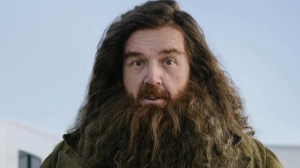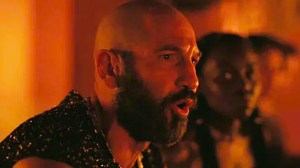Twenty years ago today, DC shocked the comics-reading world by introducing a new costume, set of powers and…skin color?…for Superman.
Videos by ComicBook.com

In Superman #123, which hit the stands on March 12, 1997 according to Mike’s Amazing World of DC Comics, a storyline that involved Superman first losing his powers, and then getting them back but having them behave erratically, culminated in the revelation that he had become an entirely energy-based life form and that in addition to a changing set of powers and abilities, he also would have to wear a “containment suit,” which would keep his body from dissipating.
The “Electric Superman” storyline was one of the most famous — or infamous, depending on who you’re asking — stunts DC attempted during the ’90s, and ultimately culminated in a new interpretation of the “Superman Red/Superman Blue” storyline from decades before — one which, a not-insignificant amount of evidence suggests, the current Superman creative teams may be revisiting again in the books currently.
How, exactly, did it all come together? Well, during the course of several interviews conducted over the last week and a half, ComicBook.com discovered that there were, essentially, two key players as well as a number of high concepts at play.
Both the costume change and the idea of altering Superman’s powers had been toyed with in the past, and colorist Glenn Whitmore had brought up the idea of reimagining “Superman Red/Superman Blue” numerous times, as well. All of it seemingly came together after The Adventures of Superman writer Karl Kesel proposed the power and costume change come as a package deal, which in turn gave an in-story reason to enact Whitmore’s suggestion.
“We were always looking for big stories to do with Superman and those usually involved the idea of changing up the status quo in some way,” explained Dan Jurgens, then the writer on Superman and currently the writer on Action Comics. “We had discussed the general idea of a costume change even back when we brought [Superman] back from the dead, of course. That was part of the inspiration for the all black costume. So we kind of revived some of that here and also went with a change in powers, which we’d also talked about previously.”
There was a lot of collaboration in those days, born in no small part out of the Superman Summits. With four monthly Superman comics on the stands and a tightly-knit continuity running between them, the different Superman creative teams often seemed like pieces of a larger whole rather than independent creators of their own comics. In the days before e-mail, online group chats, and the like were omnipresent, the idea of working on comics that required that much give-and-take was daunting, so then-Superman group editor Mike Carlin established a (mostly) yearly meeting that would bring everyone together at the DC offices in New York to plot out the year’s comics.

The Superman Summits were noisy, crowded, and unpredictable — with the Death of Superman story in 1992 famously spinning (in part) out of a snarky joke that Jerry Ordway made. They would also become a model other editorial offices in and out of DC would attempt to emulate, and would outlive Carlin’s tenure as group editor.
“When we used to do the Superman Summits we included all four writers, all four pencilers, all four inkers AND the colorist even. And as corny as it seems doing SOMETHING with “Superman Red/Superman Blue” was suggested by colorist Glenn Whitmore,” said Mike Carlin, now an executive who oversees DC animation projects but then the executive editor at DC. While Carlin did not directly oversee the Electric Superman transition — that was Joey Cavalieri — he had been the mind behind the creation of the massive “Super Summits,” and would continue to participate in those events for years.
“We worked very hard not to simply discount any ideas no matter what corner of the room they came from — and we were all fans of the original ‘Imaginary Story,’ but we wanted to do something new that was something the particular team we had assembled at that time wanted to get behind,” Carlin added. “Now if the writers and artists couldn’t come up with something the room wanted to do we wouldn’t have done it. People joined in with ideas and suggestions…and the Power Surge idea was fleshed out.”
By “people,” it seems, Carlin largely means Kesel, who told ComicBook.com he had already discussed the power change idea with editorial, and with Jurgens, before the summit began.
“The idea had come into my mind to give Superman completely different powers. Not only would this be a fun monkey wrench to throw at Our Hero, but on a story level I saw lots of possibilities to show Superman struggling — something not easy to do or often seen with Superman,” Kesel told ComicBook.com. “For the first time, he wouldn’t know what he was capable of, he wouldn’t know what could or couldn’t hurt him. I liked the idea of showing Superman learning, pushing himself, sometimes failing because, well, that didn’t work. It also gave us the opportunity to give fights with old enemies a new twist. In the end, though, the real point of the arc would be: it isn’t the powers that make Superman who is is, it’s Superman himself. I had no idea what those new powers might be — and I actually wanted other people to contribute that part so that more people were invested in the story. I believe Jon Bogdanove suggested energy powers.”
In the early days of the storyline, Jurgens and Carlin insist that the creative teams always knew that it was going to end up with two Supermen, Red and Blue, but the audience certainly didn’t. At that point, the creative team were selling the change to the audience largely as a new challenge for the Man of Steel, who had at that point been living with his powers for more than a decade even in in-story time.
“We thought it was time to make things a little tougher for Superman,” Cavalieri told Wizard: The Guide to Comics in 1997. “And since we’ve already killed him, it seemed the way to do it was to get him powers he was unfamiliar with, and have him learn how to walk again.”
That element — “learning to walk again” — came from Kesel’s pitch for new powers and a new costume, but the dueling personalities of Superman Red and Superman Blue came from Whitmore.
That’s an element of the story that Kesel told us he had no particular recollection of when we asked him about how it impacted his run on The Adventures of Superman, but it’s the part that Whitmore felt could lend the power change story some dramatic heft — and which he was pleasantly surprised to learn was being used.
“Comics is a visually symbolic medium,” then Superman: The Man of Steel writer Louise Simonson said in the Wizard interview. “When you make a big change in a character, people need to recognize that a big change has been made just by looking at that character. That’s part of the reason for coming up with the idea to change the costume.”
Bogdanove, for his part, was the missing link who explained that both Carlin’s recollection that Whitmore had come up with the idea, and Kesel’s remembrance that it was his power change pitch that eventually became the Electric Superman.
“I think the power change would be Karl’s,” Bogdanove said. “The idea that Glenn came up with, with the color change, I loved. Carlin had seemed charmed by that idea.”
“Over the years, we talked several times about doing ‘Superman Red/Superman Blue’ somehow,” Jurgens said, citing Whitmore’s desire to do so. “In this case, we finally had a story where it would actually fit.”
“Every year at the Super-summit, it would become the running gag that I (as colorist) would pitch the idea, though I was serious about it. Being someone who loved the Silver Age, I simply envisioned in my mind that Superman would be drawn by the artists as Curt Swan drew him. The story would simply be one about a split personality; Red would have the more aggressive personality while Blue was the more cerebral and thoughtful one,” Whitmore explained. “I have the distinct memory of being in the conference room and pitching that idea. Everyone began to laugh at me. This idea had everyone in stitches as if it was the most inane idea ever pitched. In those days, I was the youngest of the group with the reputation of a goofball. Anyhow, I was dead serious when I pitched it. Not being a writer, I probably had trouble articulating what was in my head. Every year after, I would seriously mention it, yet still knowing it would get laughs out of the rest of the Super crew. Somewhere along the way, budgets were cut and the colorist could no longer attend the Super-Summits. KC Carlson had become editor at this point, and when I made a visit to the office (after missing that particular Super-summit), I laughed when I saw the notes for Superman Red/Blue on the plot grids. I had absolutely nothing to do with the costume and powers redesign aspect, but some of the personality split aspects made it into the storyline.”
You can check back early in the week for a wide-ranging roundtable conversation with these creators and more about the 20th anniversary of the “Electric Superman” storyline.
This story has been updated to add comments from longtime Superman colorist Glenn Whitmore.
Thanks to Michael Bailey at the Fortress of Baileytude for providing copies of the 1997 Wizard Magazine and Previews articles that helped serve as research for this and other stories in our series on Electric Superman.
More Electric Superman news:









